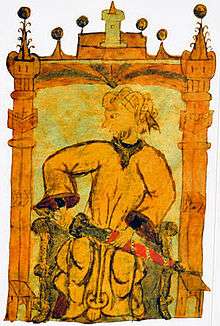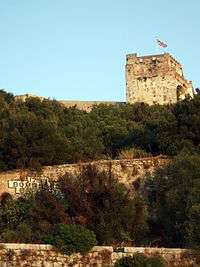Tariq ibn Ziyad
Ṭāriq ibn Ziyād (Arabic: طارق بن زياد) also known simply as Tarik in English, was a Berber Umayyad commander who initiated the Muslim conquest of Visigothic Hispania (Present day Spain and Portugal) in 711–718 A.D. He led a large army and crossed the Strait of Gibraltar from the North African coast, consolidating his troops at what is today known as the Rock of Gibraltar. The name "Gibraltar" is the Spanish derivation of the Arabic name Jabal Ṭāriq (جبل طارق), meaning "mountain of Ṭāriq",[1] which is named after him.
Ṭāriq ibn Ziyād طارق بن زياد | |
|---|---|
 | |
| Allegiance | Umayyad Caliphate |
| Rank | General |
| Battles/wars | Conquest of Hispania • Battle of Guadalete |
| Other work | Governor of Tangier Governor of Al-Andalus |
Origins
Medieval Arabic historians give contradictory data about Tariq's origins or nationality. Some conclusions about his personality and the circumstances of his entry into al-Andalus are surrounded by uncertainty.[2] The vast majority of modern sources state that Tariq was a Berber mawla of Musa ibn Nusayr, the Umayyad governor of Ifriqiya.[2][3][4][5]
History

Musa ibn Nusayr appointed Ṭāriq governor of Tangier after its conquest in 710-711 according to Ibn Abd al-Hakam (803-871),[6] but an unconquered Visigothic outpost remained nearby at Ceuta, a stronghold commanded by a nobleman named Julian, Count of Ceuta.
After Roderic came to power in Spain, Julian had, as was the custom, sent his daughter, Florinda la Cava, to the court of the Visigothic king for education. It is said that Roderic raped her, and that Julian was so incensed he resolved to have the Muslims bring down the Visigothic kingdom. Accordingly, he entered into a treaty with Ṭāriq (Mūsā having returned to Qayrawan) to secretly convoy the Muslim army across the Straits of Gibraltar, as he owned a number of merchant ships and had his own forts on the Spanish mainland .
About April 26, 711, the army of Ṭāriq, composed of recent converts to Islam, was landed on the Iberian peninsula (Spain) by Julian.[7] They debarked at the foothills of a mountain which was henceforth named after him, Gibraltar (Djabal Tarik).[8]
Tariq's army contained about 7,000 Berber horsemen, and Mūsā is said to have sent an additional 5,000 reinforcements after the conquest.[9] Roderic, to meet the threat of the Berbers, assembled an army said to number 100,000.[10] Most of the army was commanded by, and loyal to, the sons of Wittiza, whom Roderic had brutally deposed.[11] Ṭāriq won a decisive victory when Roderic was defeated and killed on July 19 at the Battle of Guadalete.[2][12]
Tariq split his army into four divisions which went on to capture Córdoba under Mughith al-Rumi, Granada and other places, while he remained at the head of the division which captured Toledo. Afterwards, he continued advancing towards the north, reaching Guadalajara and Astorga.[2] Ṭāriq was de facto governor of Hispania until the arrival of Mūsā a year later.
Both Tariq and Musa were simultaneously ordered back to Damascus by the Umayyad Caliph Al-Walid I in 714, where they spent the rest of their lives.[12] The son of Musa, Abd al-Aziz who took the command of troops of Al-Andalus was assassinated in 716.[3] In the many Arabic histories written about the conquest of southern Spain, there is a definite division of opinion regarding the relationship between Ṭāriq and Musa bin Nusayr. Some relate episodes of anger and envy on the part of Mūsā, that his freedman had conquered an entire country. Others do not mention, or play down, any such bad blood. On the other hand, another early historian al-Baladhuri (9th century) merely states that Mūsā wrote Ṭāriq a "severe letter" and that the two were later reconciled.[13]
Speech
The 16th-century historian Ahmed Mohammed al-Maqqari, in his The Breath of Perfume, places into Ṭāriq's mouth a long speech to his troops before Guadalete.[14][15][16]
References
- "History of Gibraltar". Government of Gibraltar. Archived from the original on January 3, 2008. Retrieved 2007-12-20.
- Molina 2000, p. 242.
- Abun-Nasr 1993, p. 71.
- Kennedy 1996, p. 6.
- Nicolle 2009, p. 64.
- Alternatively, he was left as governor when Mūsā's son Marwan returned to Qayrawan. Both explanations are given by Ibn Abd al-Hakam, p. 41 of Spanish translation, p. 204 of Arabic text.
- There is a legend that Ṭāriq ordered that the ships he arrived in be burnt, to prevent any cowardice. This is first mentioned over 400 years later by the geographer al-Idrisi, fasc. 5 p. 540 of Arabic text (Arabic: فٱمر بإحراق المراكب), vol. 2 p. 18 of French translation. Apart from a mention in the slightly later Kitāb al-iktifa fī akhbār al-khulafā (English translation in Appendix D of Gayangos, The History of the Mohammedan Dynasties in Spain) this legend was not sustained by other authors.
- Molina 2000, p. 243.
- Akhbār majmūa, p. 21 of Spanish translation, p. 6 of Arabic text.
- Akhbār majmūa p. 8 of Arabic text, p. 22 of Spanish translation.
- According to some sources, e.g., al-Maqqari p. 269 of the English translation, Wittiza's sons by prior arrangement with Ṭāriq deserted at a critical phase of the battle. Roger Collins takes an oblique reference in the Mozarab Chronicle par. 52 to mean the same thing.
- Reilly 2009, p. 52.
- P. 365 of Hitti's English translation.
- Falk, Avner (2010). Franks and Saracens: Reality and Fantasy in the Crusades. p. 47.
- McIntire, E. Burns, Suzanne, William (2009). Speeches in World History. p. 85.
- Charles Francis Horne (1917). The Sacred Books and Early Literature of the East: With Historical Surveys of the Chief Writings of Each Nation... VI: Medieval Arabia. Parke, Austin, and Lipscomb. pp. 241–242.
Sources
Primary sources
- Pascual de Gayangos y Arce, The History of the Mohammedan Dynasties in Spain. vol. 1. 1840. English translation of al-Maqqari.
- al-Baladhuri, Kitab Futuh al-Buldan, English translation by Phillip Hitti in The Origins of the Islamic State (1916, 1924).
- Anon., Akhbār majmūa fī fath al-andalūs wa dhikr ūmarā'ihā. Arabic text edited with Spanish translation: E. Lafuente y Alcantara, Ajbar Machmua, Coleccion de Obras Arabigas de Historia y Geografia, vol. 1, Madrid, 1867.
- Anon., Mozarab Chronicle.
- Ibn Abd al-Hakam, Kitab Futuh Misr wa'l Maghrib wa'l Andalus. Critical Arabic edition of the whole work published by Torrey, Yale University Press, 1932. Spanish translation by Eliseo Vidal Beltran of the North African and Spanish parts of Torrey's Arabic text: "Conquista de Africa del Norte y de Espana", Textos Medievales #17, Valencia, 1966. This is to be preferred to the obsolete 19th-century English translation at: Medieval Sourcebook: The Islamic conquest of Spain
- Enrique Gozalbes Cravioto, "Tarif, el conquistador de Tarifa", Aljaranda, no. 30 (1998) (not paginated).
- Muhammad al-Idrisi, Kitab nuzhat al-mushtaq (1154). Critical edition of the Arabic text: Opus geographicum: sive "Liber ad eorum delectationem qui terras peragrare studeant." (ed. Bombaci, A. et al., 9 Fascicles, 1970–1978). Istituto Universitario Orientale, Naples. French translation: Jaubert, P. Amédée, trans. & ed. (1836–1840). Géographie d'Édrisi traduite de l'arabe en français d'après deux manuscrits de la Bibliothèque du roi et accompagnée de notes (2 Vols). Paris: L'imprimerie Royale.CS1 maint: extra text: authors list (link).
- Ibn Taghribirdi, Nujum al-zahira fi muluk Misr wa'l-Qahira. Partial French translation by E. Fagnan, "En-Nodjoum ez-Zâhîra. Extraits relatifs au Maghreb." Recueil des Notices et Mémoires de la Société Archéologique du Département de Constantine, v. 40, 1907, 269-382.
- Ibn Khallikan, Wafayāt al-aʿyān wa-anbāʾ abnāʾ az-zamān. English translation by M. De Slane, Ibn Khallikan's Biographical dictionary, Oriental Translation Fund of Great Britain and Ireland, 1843.
- Ibn Idhari, Kitāb al-bayān al-mughrib fī ākhbār mulūk al-andalus wa'l-maghrib. Arabic text ed. G.S. Colin & E. Lévi-Provençal, Histoire de l'Afrique du Nord et de l'Espagne intitulée Kitāb al-Bayān al-Mughrib, 1948.
Secondary sources
- Abun-Nasr, Jamil M. (1993). A History of the Maghrib in the Islamic Period. Cambridge University Press.CS1 maint: ref=harv (link)
- Collins, Roger (1995) [1989]. The Arab Conquest of Spain: 710 - 797. Wiley. ISBN 978-0-631-19405-7.
- Djait, Hichem (2008). تأسيس الغرب الإسلامي (in Arabic) (2nd ed.). Beirut: دار الطليعة. ISBN 9953410879.CS1 maint: ref=harv (link)
- Ivan Van Sertima (1992). Golden Age of the Moor. ISBN 9781412815369. Retrieved August 23, 2012.
- Kennedy, Hugh (1996). Muslim Spain and Portugal: A Political History of al-Andalus. Routledge. ISBN 9781317870418.CS1 maint: ref=harv (link)
- Molina, L. (2000). "Ṭāriḳ b. Ziyād". In Bearman, P. J.; Bianquis, Th.; Bosworth, C. E.; van Donzel, E.; Heinrichs, W. P. (eds.). The Encyclopaedia of Islam, New Edition, Volume X: T–U. Leiden: E. J. Brill. ISBN 90-04-11211-1.
- Nicolle, David (2009). The Great Islamic Conquests AD 632–750. Bloomsbury Publishing. ISBN 9781846032738.CS1 maint: ref=harv (link)
- Reilly, Bernard F. (2009). The Medieval Spains. New York: Cambridge University Press. ISBN 978-0-521-39741-4.CS1 maint: ref=harv (link)
External links
- Pascual de Gayangos y Arce, The History of the Mohammedan Dynasties in Spain.. vol. 1. 1840. Authoritative English translation of al-Maqqari available from Google eBooks. This is the translation still cited by modern historians.
- Tarik's Address to His Soldiers, 711 CE, from The Breath of Perfumes. A translation of al-Maqqari's work included in Charles F. Horne, The Sacred Books and Early Literature of the East, (New York: Parke, Austin, & Lipscomb, 1917), Vol. VI: Medieval Arabia, pp. 241–242. Horne was the editor, the translator is not identified. NB: the online extract, often cited, does not include the warning on p. 238 (download the whole book from other sites): "This speech does not, however, preserve the actual words of Tarik; it only presents the tradition of them as preserved by the Moorish historian Al Maggari, who wrote in Africa long after the last of the Moors had been driven out of Spain. In Al Maggari's day the older Arabic traditions of exact service had quite faded. The Moors had become poets and dreamers instead of scientists and critical historians."
- Ibn Abd al-Hakam, rather outdated English translation in Medieval Sourcebook: The Islamic Conquest of Spain
| New title | Governor of Al-Andalus 711–712 |
Succeeded by Musa ibn Nusayr |